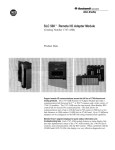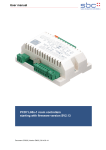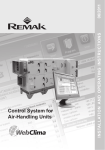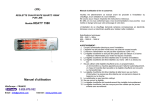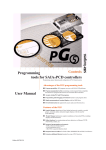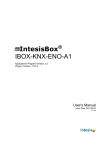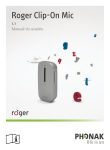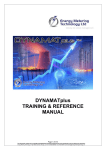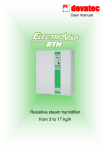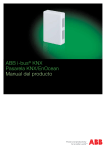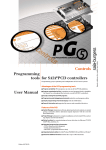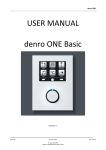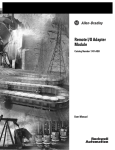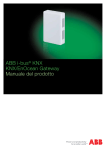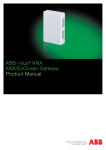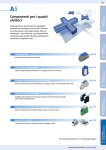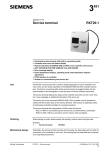Download - Show more
Transcript
User manual the compact PCD7.L79xN room controller Controls Division Document 27/602; Version EN02 │ 2013-08-20 Saia-Burgess Controls AG Manual for PCD7.L79xN room controllers │ Document 27 / 602 EN02 │ 2013-08-20 Saia-Burgess Controls AG 0Contents 0.1 Document History ............................................................................................ 0-3 0.2Trademarks ..................................................................................................... 0-3 Contents 0 1Overview 1.1 PCD7.L79xN series | compact room controller with Serial S-Net .................... 1-1 1.2 Possible uses for the PCD7.L79xN series ...................................................... 1-3 1.2.1 Standalone control with no communication ..................................................... 1-3 1.2.2 Standalone control with communication to the automation station ................. 1-3 1.2.3 External regulation and control via the automation station .............................. 1-4 1.3 Application overview for the PCD7.L79xN series ........................................... 1-5 1.3.1 Device overview and technical details of the compact room controller ........... 1-6 1.3.2 Phased-out room controllers ........................................................................... 1-8 2 2.1 2.2 2.2.1 2.3 Commissioning instructions Safety instructions ........................................................................................... 2-1 Assembly instructions ...................................................................................... 2-2 Mounting / Disassembly .................................................................................. 2-3 Procedure for the temperature calibration on commissioning ......................... 2-4 3Function 3.1Communication ............................................................................................... 3-1 3.1.1 Functions, commissioning ............................................................................... 3-1 3.2 Functions, settings .......................................................................................... 3-5 3.2.1 Functions, settings, room control unit .............................................................. 3-6 3.2.2 Functions, settings, operation ......................................................................... 3-6 3.2.3 Functions, settings, hardware ......................................................................... 3-9 3.2.4 Functions, settings, control parameters .......................................................... 3-14 3.3 Functions, control ............................................................................................ 3-17 3.4 Functions, regulation ....................................................................................... 3-22 3.5 Functions, actual values .................................................................................. 3-24 3.6 Functions, manual output control .................................................................... 3-26 3.7 Functions, master/slave .................................................................................. 3-28 4 Example applications 4.1General ............................................................................................................ 4-1 4.2 System requirements ..................................................................................... 4-1 4.3Initialisation ...................................................................................................... 4-1 4.4 Configuration ................................................................................................... 4-2 4.5Function ........................................................................................................... 4-3 4.6 Control of free outputs ..................................................................................... 4-3 4.7 Remote IO ....................................................................................................... 4-4 5 5.1 5.2 Register usage Registers, configuration ................................................................................... 5-1 Registers, actual values .................................................................................. 5-5 Manual for PCD7.L79xN room controllers │ Document 27 / 602 EN02 │ 2013-08-20 0-1 Saia-Burgess Controls AG 6 6.1 6.1.1 6.1.2 6.1.3 6.1.4 6.2 6.2.1 6.2.2 6.2.3 6.2.4 Technical data Room controllers with Serial S-Net ................................................................. 6-1 Performance data for Serial S-Net .................................................................. 6-1 Electrical load on Serial S-Net ......................................................................... 6-2 Technical overview of room controllers PCD7.L790N - .L793N ...................... 6-3 Dimension of room-controller PCD7.L790N - .L793N ..................................... 6-4 Type description .............................................................................................. 6-5 Technical data for PCD7.L790N ...................................................................... 6-5 Technical data for PCD7.L791N ...................................................................... 6-7 Technical data for PCD7.L792N ...................................................................... 6-9 Technical data for PCD7.L793N ...................................................................... 6-11 Contents 0 AAppendix A.1Icons ................................................................................................................ A-1 A.2 Order codes ..................................................................................................... A-2 A.3 Address of Saia-Burgess Controls AG ............................................................ A-3 Manual for PCD7.L79xN room controllers │ Document 27 / 602 EN02 │ 2013-08-20 0-2 Saia-Burgess Controls AG 0.1 Contents Document History Date Version Changes Remarks 2011-11-28 2013-08-20 EN01 EN02 overall Document derived from the manual 26/868 Logo and company name changed 0 0.2Trademarks Saia PCD® and Saia PG5® are registered trademarks of Saia-Burgess Controls AG Subject to technical changes Saia-Burgess Controls AG, 2011. © All rights reserved. Published in Switzerland Manual for PCD7.L79xN room controllers │ Document 27 / 602 EN02 │ 2013-08-20 0-3 Saia-Burgess Controls AG Overview PCD7.L79xN series 1Overview 1.1 PCD7.L79xN series | compact room controller with Serial S-Net With single room control for individual comfort and energy efficiency 1 The PCD7.L79xN single room controllers enable users to adjust the room climate to their individual needs. The controllers have an internal temperature sensor and some models have a setpoint control as well as a presence key with LED display All devices in the PCD7.L79xN product family can be run as standalone control devices or connected directly to the automation station as Serial S-Net slaves. Various applications provide different control and operating options in Serial S-Net operation. In RIO operating mode, control can be executed entirely externally in the master station. In this case, the single room controller is used simply as a hardware input / output for climate control. Serial S-Net-Bus S-Bus, RS-485, Data-Mode The different usage and operating modes The functionality of the single room controller is based on various different usage and operating modes. And each selectable operating mode can be assigned different set points. Non-use No heating or cooling energy is routed to the room. This state is useful when a window is open. The room controller keeps the room temperature above the frost threshold of 8 °C. Manual for PCD7.L79xN room controllers │ Document 27 / 602 EN02 │ 2013-08-20 1-1 Saia-Burgess Controls AG Overview PCD7.L79xN series Non-use/standby The room is prepared for use, but no presence has yet been registered in the room. As long as the room is not flagged as occupied by teh presence function, the room controller maintains the room temperature within the specified limits at standby level. 1 Use The room is in use and should be brought to a comfortable temperature. The state can be reached by pressing the presence key, addressing an external presence sensor or sneding an instruction over the network. Library of function objects The PCD7.L79xN Room Control library pf function objects for the single room controllers can be downloaded free of charge from the Saia Burgess Controls home page at: www.sbc-support.com Manual for PCD7.L79xN room controllers │ Document 27 / 602 EN02 │ 2013-08-20 1-2 Saia-Burgess Controls AG Overview Possible uses 1.2 Possible uses for the PCD7.L79xN series 1.2.1 Standalone control with no communication 1 The controller regulates the room temperature without any connection to a bus system. Control is handled entirely by the individual room controller based on the specified default parameter settings. The outputs are driven by a control algorithm depending on the measured temperature. M P T The default set-point setting of 21 °C can be modified by the set-point control (according to the device). 1.2.2 Standalone control with communication to the automation station The controller is run as a slave station with a unique Bus address within a serial S-Net system. Control is handled by the individual room controller with its own control algorithm. The control functions - time or event-driven - are passed to the individual room controller by the automation station via suitably configurable function objects or network variables. This supports individual parameterisation and operation of the room controller. The device, and hence the control function, can also be influenced at any time via the Saia PCD® master station. Se ria l SNe t, Lo nW or ks® ,B AC M ne t® P T For parameterisation, there is a function object available in the library for every room controller type. In the case of open network connections, this is handled via network variables or network objects. Manual for PCD7.L79xN room controllers │ Document 27 / 602 EN02 │ 2013-08-20 1-3 Saia-Burgess Controls AG Overview Possible uses 1.2.3 External regulation and control via the automation station The Saia PCD® master station handles all regulation and control tasks. The room controller itself is only used as a remote input / output unit. Regulation and control can then be adapted to requirements in a very flexible way. For parameterization, RIO function objects are provided in the room controller library. Se ria l SNe t, RIO 1 Lo nW or ks® ,B M AC ne t® P T Manual for PCD7.L79xN room controllers │ Document 27 / 602 EN02 │ 2013-08-20 1-4 Saia-Burgess Controls AG Overview Application overview 1.3 Application overview for the PCD7.L79xN series Communication-friendly control of all standard heating/cooling elements with SBC Serial S-Net, including: ■Radiators / heating, cooling with changeover ■Radiator/cooled ceiling combinations ■Variable Air Volume (VAV) systems 1 2-tube for heating, cooling or changeover Application Room controllers Valves Room control PCD7.L790N PCD7.L791N 24 V PWM 24 V PWM or 24 V 3-point 24 V PWM or 24 V 3-point 24 V PWM or 24 V 3-point or 0…10 V - Valves Room control yes yes PCD7.L792N PCD7.L793N yes yes 4-tube for heating, cooling or changeover Application Cooling ceiling + VAV Room controllers PCD7.L791N PCD7.L792N PCD7.L793N 24 V PWM 24 V PWM 24 V PWM or 0…10 V Radiator Manual for PCD7.L79xN room controllers │ Document 27 / 602 EN02 │ 2013-08-20 1-5 Saia-Burgess Controls AG Overview Application overview 1.3.1 Device overview and technical details of the compact room controller 1 Type: PCD7. ... L790 N Functions One output sequence Two output sequences TRIAC output 0…10 V output Changeover function Presence key Set-point setting LED display S-Bus slave operation NTC Internal temperature sensor Additional inputs: Digital inputs: presence / window Analogue inputs 0…10 VDC: L791N L792N L793N × × × × × × × × × × × × × × × × × × × × × × × × × × 2 2 2 2 × 1 General details Temperature sensor, internal: NTC 10 kΩ / 0…40 °C Control behavior: P or PI behavior Communication interface: SBC S-Bus / RS-485 interface / Data mode / 4 800, 9 600, 19 200, 38 400, 115 200 bit/s with automatic detection at restart time. Power consumption: 1.5 W without actuating drives TRIAC output specification: 24 VAC /800 mA max. TRIAC mode: Zero-current connection (default setting) / direction invertible Output spec. 0…10 VDC:0…10 VDC / max. load 2 mA Housing: Plastic, white, surface mounted, IP20 protection Dimensions:82 × 117 × 31 mm (W × H × D) Manual for PCD7.L79xN room controllers │ Document 27 / 602 EN02 │ 2013-08-20 1-6 Saia-Burgess Controls AG Overview Application overview Maximum number of room controllers The maximum number of room controllers that can be processed by a PCS / PCD system is dependent on the Bus cycle time and the resources used by the function objects. Resources: max. 600 lines of code per FBox , max. 30 registers per FBox, max. 10 flags per FBox, 1 DB Bus cycle time per controller: approx. 15 ms PCD program cycles: 428 for 150 FBoxes, measured with PCD3.M5540 1 Commissioning When the room controller is used in a SBC S-Bus network, configuration is either by the Saia Burgess Controls PCS/PCD Master or the Saia PG5® programming tool. Practical function blocks (FBoxes) simplify commissioning. FBox library Saia PG5® FUPLA FBox-Selector The "Room Control PCD7.L79xN" FBox library for the single room controller contains all the FBoxes needed for Saia PG5®. It can be dlwonloaded free of charge from the Saia Burgess Controls home page at: www.sbc-support.com Manual for PCD7.L79xN room controllers │ Document 27 / 602 EN02 │ 2013-08-20 1-7 Saia-Burgess Controls AG Overview Application overview 1.3.2 Phased-out room controllers Item Active since PCD7.L790N December 2011 PCD7.L791N December 2011 PCD7.L792N December 2011 PCD7.L793N December 2011 Not recommended Phased out (production ceased) for new valid until / Commercial Info projects Manual for PCD7.L79xN room controllers │ Document 27 / 602 EN02 │ 2013-08-20 1 1-8 Saia-Burgess Controls AG Commissioning instructions Safety instructions 2 Commissioning instructions 2.1 Safety instructions To guarantee safe operation, the PCD7.L79xN devices should only be operated by qualified staff according to the details given in the operating instructions and in compliance with the technical data. Qualified staff are people familiar with the assembly, commissioning and operation of the devices and suitably trained for their job. 2 When using the system, the legal and safety regulations applicable to the specific type of use must also be observed. The room controllers have undergone a comprehensive pre-delivery inspection, ensuring that they left the factory in perfect condition. Before commissioning, the devices should be checked for damage arising from incorrect transport or storage. Removal of the identification numbers will invalidate the warranty. Please ensure that the limits specified in the technical data are not exceeded. Failure to do so may result in defects in the modules and the perpiherals connected to them. We can accept no responsibility for damage arising from improper deployment and use. The plugs must never be inserted or removed with the power on. When installing or de-installing the modules, all components must be switched off. Please read this manual carefully before assembling and commissioning the modules. This manual contains instructions and warnings that must be observed to assure safe operation. Manual for PCD7.L79xN room controllers │ Document 27 / 602 EN02 │ 2013-08-20 2-1 Saia-Burgess Controls AG Commissioning instructions Assembly instructions 2.2 Assembly instructions ■ The compact room controllers must only be installed and connected by an expert in accordance with the wiring diagram. Existing safety standards must also be observed. ■ The individual room controller can only be used to regulate the temperature in dry, closed rooms. The maximum permissible relative humidity is 90%, noncondensing. 2 ■ Precise temperature measurement is subject to certain requirements as to the positioning of the compact room controllers. ■ The device can be mounted directly on the wall or flush-mounted within a pattress box. Avoid direct exposure to sunlight or light from powerful lamps. 1.5 m Do not install next to windows and doors because of draughts. Do not install next to heat sources such as heaters, refrigerators, lamps etc. Do not fit the compact room controller on places where airflow trough the direct air blowing of a VAV or Ventilation System or trough a downwind of cold air above the compact room controller exist. Avoid other temperature perturbation on the device Manual for PCD7.L79xN room controllers │ Document 27 / 602 EN02 │ 2013-08-20 2-2 Saia-Burgess Controls AG Commissioning instructions Assembly instructions 2.2.1 Mounting / Disassembly Open the housing The screw on the underside of the unit unscrew something. Remove lid down over the screw a bit of time. Then hang at the top of the lid and remove it altogether. 117 60 84 55.80 6 3. 10 2 Cable implementation Terminals 55.80 83.50 It should be noted: ●● ●● ●● ●● that all wires are screwed down tight that the ventilation slots are placed above and below (positioning) that the device is mounted horizontally that the 2 holes for the cable feed-in have to be sealed (for example with polyurethane foam or with the wall isolation) that airflow in to the controller from the cable duct which could influence the temperature measuring can be prevent. Close the housing Analogously, in reverse order as described in “Open the housing” to proceed. Manual for PCD7.L79xN room controllers │ Document 27 / 602 EN02 │ 2013-08-20 2-3 Saia-Burgess Controls AG Commissioning instructions Procedure for the temperature calibration on commissioning 2.3 Procedure for the temperature calibration on commissioning A predefined static and dynamic offset are already configured in the factory settings, but as common known, to get a better accuracy it is necessary to make a calibration for the different ambient- and installation-conditions on the commissioning. 1) Static calibration (Register 8) a) Power-on of the controller without connected thermal valves (or deactivation of the PWM outputs). b) After several hours of operation, the temperature has to be measured near to the lower air slots and to compare with the measured temperature of the controller. 2 Location where the air temperature has to be mesured c) The calibration can be set in the Room-FBox “Correction temperature °K” or it can be written to register 8. Note:This parameter is only applicable if the temperature sensor is selected as “L79x” (in the config-FBox) Manual for PCD7.L79xN room controllers │ Document 27 / 602 EN02 │ 2013-08-20 2-4 Saia-Burgess Controls AG Commissioning instructions Procedure for the temperature calibration on commissioning Carry out only if necessary: 2) Dynamic calibration (Register 29) This setting depends on the connected thermal valves type and quantity and on the installation-conditions. This calibration is not mandatory and can be performed at specific room constellation in which the measurement accuracy is not sufficient. a) Connect the thermal valves and activate (over the setpoint) the PWM outputs to 100 %. 2 b) After 30 minutes the temperature has to be measured near to the lower air slots and to compare with the measured temperature of the controller. c) When the displayed temperature of the controller is too high, then it is possible to set a higher stage for the “dynamic correction” (stage 1 up to 5). Stage Effect None Without dynamic correction 1 2 3 increase of the dynamic correction 4 5 Maximum → for several parallel connected valves Manual for PCD7.L79xN room controllers │ Document 27 / 602 EN02 │ 2013-08-20 2-5 Saia-Burgess Controls AG Function Communication 3Function 3.1Communication 3.1.1 Functions, commissioning Automatically detecting the Serial S-Net baudrate After the current is switched on, the compact room controllers attempt to detect the baudrate on the S-Bus for themselves. During this time, the controller does not function. For this, it is necessary for the communication master to send telegrams on a cyclical basis. Where a Saia PCD® is used, this task is handled by the "Setup" FBox from the "PCD7_L79x room controller" group. Once the room controller has detected the baudrate, it stores this information. After a restart, it will begin by setting this baudrate. Only when the room controller cannot establish any communication with the last used baudrate does it restart baudrate detection. 3 The picture shows a SASI interface initialisation and the Setup FBox. The activated Setup FBox makes cyclical attempts to establish a connection to station address 252 (see service pin on the room controller). As the service pin is not normally activated on any room controller, station address 252 is not present. The LED for the SASI S-Bus master FBox is then red. After successful commissioning of the room controllers, it is therefore advisable to deactivate the Setup FBox via the "Enable" input. If proper communication is established, the LED for the SASI S-Bus master FBox should stay green. Manual for PCD7.L79xN room controllers │ Document 27 / 602 EN02 │ 2013-08-20 3-1 Saia-Burgess Controls AG Function Communication Setting the S-Bus service pin With a small screwdriver or paper clip, can be actuated the service pin by the vents. Service-Pin 3 When the "Service pin" button is pressed, the compact room controller enables an additional station address 252 for a minimum of 15 minutes. The controller can use this address to communicate with the master independently of all other software components. Provided that the room controller is receiving telegrams via this address, the timer for time monitoring is restarted each time. Only when the timer expires (after 15 minutes) is station address 252 deactivated. Please note that two controllers cannot be activated at the same time via the service pin. To terminate the timer prematurely, register 60 can also be manually set to 0, e.g. via the Setup FBox, a communication FBox or the debugger. Setting the station address The station address can be parameterised via the Setup FBox or directly in register 110. Example: Addressing using a Saia PCD® and FBoxes - Activate station address 252 on the room controller by pressing the "service pin" button - In the case of correct S-Bus communication, the Connect output on the FBox will be 'high'. - Open Setup FBox, Adjust window. - If communication is "online", enter a new station number, copy to the Saia PCD® and click the "Setup" button. Example: Addressing with a Saia PCD® via the debugger This requires a gateway to be parameterised in the Saia PCD® hardware settings and the SASI master FBox. - Activate station address 252 on the room controller by pressing the "service pin" button Manual for PCD7.L79xN room controllers │ Document 27 / 602 EN02 │ 2013-08-20 3-2 Saia-Burgess Controls AG Function Communication - Connect Sbus 252. - Write Register 110 - new station number. - Write Register 60 - 0. 3 Automatic configuration The compact room controllers can be configured automatically via the Config and Room FBoxes. After every restart, a flag is passed to the Room FBox to tell it that the controller has been restarted. The FBox then checks that the configuration matches the associated Config FBox. If this is not the case, all the control parameters are copied over automatically from the Config FBox to the compact room controller. This option reduces commissioning to the address-setting operation. This means that after a device replacement in the course of support work, functionality can be reliably restored by the Saia PCD® alone. See also the description of the individual functions in the following sections. Manual for PCD7.L79xN room controllers │ Document 27 / 602 EN02 │ 2013-08-20 3-3 Saia-Burgess Controls AG Function Communication Firmware version The Setup FBox provides details of the type and firmware version. Where there is a connection to the room controller, the "Controller type" and "Firmware version" are displayed in the Setup FBox. 3 Manual for PCD7.L79xN room controllers │ Document 27 / 602 EN02 │ 2013-08-20 3-4 Saia-Burgess Controls AG Function Functions, settings 3.2 Functions, settings The L79x compact room controllers have an integrated, parameterised control program. The parameters can be used to define the behaviour of the individual functions such as the room control unit, hardware and regulation. The settings can be entered automatically or manually via the "Config" FBox, or set via individual S-Bus registers. The associated registers and their values are shown in tables in the appropriate places (see Register description Chapter 5) 3 Use of the "Config" FBox With the "from station address" and "to station address" parameters, a range of S-Bus addresses can be defined for which the subsequent configuration applies. Where automatic configuration is used, the Config FBox will automatically copy the configuration to all stations in the range. If automatic configuration has not been activated, the configuration can be written manually by pressing the "Write" button on the controller with S-Bus address "from station address", " to station address". The current contents of a controller can be displayed in the online parameters by entering the S-Bus address in the "from station address" parameter and then clicking on the "Read" button. All parameters can also be written individually as registers without using the Config FBox. Manual for PCD7.L79xN room controllers │ Document 27 / 602 EN02 │ 2013-08-20 3-5 Saia-Burgess Controls AG Function Functions, settings 3.2.1 Functions, settings, room control unit 3 Set-point step in K (register 104) The room control unit can increase or decrease the room set-point for the controller in up to 6 steps. The absolute change in the set-point is defined by the number of steps set on the room control unit and this parameter for the difference per step. Range of settings: FBox 0 ... 1 K Registers 0 ... 10 K/10 3.2.2 Functions, settings, operation Choice of application (register 9) The regulation/control functions are dependent on the program selected. This register x. is used to define the program. The associated outputs Y1…Y4 are specified in the "Hardware" section. All outputs not used by the function can be freely used for RIO (remote input-output). Application Description Terminals Y1 Triac PWM output 0…100 % Y1 Y2 Triac PWM output 0…100 % Y2 Y3 Analogue 0…10 V output 0…100 % Y3 Y4 Analogue 0…10 V output 0…100 % Y4 Manual for PCD7.L79xN room controllers │ Document 27 / 602 EN02 │ 2013-08-20 3-6 Saia-Burgess Controls AG Function Functions, settings 3 Function Value Description of outputs Outputs RIO 0 The internal regulation and control functions are disabled. All outputs are controlled via the RIO FBox or via S-Bus registers. none 2-pipe H 1 2-pipe heating application. Y1(Y3) 2-pipe CO 2 2-pipe change-over application. Where ChangeOver Y1(Y3) input == 0, the controller is in heating mode, otherwise in cooling mode. (change-over register: 38) 2-pipe C 3 2-pipe cooling application. Y1(Y3) 4-pipe H/C 5 4-pipe heating/cooling application. The heating valve is controlled via Y1(Y3), and the cooling valve via Y2(Y4). Y1(Y3), Y2(Y4) 2×2-pipe H, Y2=Y1 7 2-pipe heating application with 2 heating valves connected in parallel. The first heating valve is controlled via Y1(Y3), and the second heating valve via Y2(Y4). Y1(Y3), Y2(Y4) 2×2-pipe CO, Y2=Y1 8 2-pipe change-over application with 2 valves connected in parallel. The first valve is controlled via Y1(Y3), and the second valve via Y2(Y4). Y1(Y3), Y2(Y4) 2×2-pipe C, Y2=Y1 9 2-pipe cooling application with 2 valves connected in parallel. The first valve is controlled via Y1(Y3), and the second valve via Y2(Y4). Y1(Y3), Y2(Y4) The application selected determines the correct settings for the valve outputs and the function set for input E2 (see "Settings, hardware"). Manual for PCD7.L79xN room controllers │ Document 27 / 602 EN02 │ 2013-08-20 3-7 Saia-Burgess Controls AG Function Functions, settings Watchdog Function ... ... in “Config” FBox The behaviour of the communication watchdog can be switched between "Stop controller" (default) and "Restart controller". 3 ... in “Room” FBox The communications watchdog is run automatically from the "Room" FBox. If communication between the Room FBox and the controller is interrupted for the preset time (value multiplied by 20 seconds), the controller performs the specified action (see Config FBox). A configured value of 255 deactivates the watchdog function (default). Manual for PCD7.L79xN room controllers │ Document 27 / 602 EN02 │ 2013-08-20 3-8 Saia-Burgess Controls AG Function Functions, settings 3.2.3 Functions, settings, hardware 3 Choice of temperature sensor (register 13) The controller can derive the room temperature for control purposes from 2 different sources. FBox entry Value Meaning “L79x” 1 The room temperature is measured by the internal temperature sensor of the compact room controller. “via 2 The room temperature is passed to the controller via S-Bus. (see register 30) S-Bus” Normal state, window contact (register 105) The contact polarity of the window contact can be selected from normal (closed) or open. FBox entry Value Meaning “closed" 0 When the window is closed, the window contact is also closed. “open" 1 When the window is closed, the window contact is open. Manual for PCD7.L79xN room controllers │ Document 27 / 602 EN02 │ 2013-08-20 3-9 Saia-Burgess Controls AG Function Functions, settings Contact at terminal E2 is (register 10) This parameter can be used to configure the function of the second digital input. The status can be read independently of the configuration in register 70. Contact closed = 0, Contact open = 1 3 FBox entry “without Value function” Meaning 0 The contact has no effect on the control program. It can be used as a free digital input and processed via the Room FBox in the Saia PCD®. 1 The input is used as a second window contact. For this to work, both contacts E1 and E2 must be closed. When one or both contacts are open, the controller moves into frost protection mode. The contact polarity should be noted here. “ChangeOver” 2 The input is used to switch between heating/cooling mode in change-over applications. When the contact is closed, the controller works in cooling mode, otherwise in heating mode. “Dew 3 An external dew point switch, together with the integrated dew point function, enables the controller to switch off the cooling function and prevent further condensation. When the contact is closed, cooling is enabled within the program. If the contact is open, cooling is blocked. (see register 39) detector” 4 An external presence sensor enables the controller to switch into Comfort or unused/Standby mode. The internal presence status can be determined from register 35. For Comfort mode, the contact must be closed. Temperature sensor input fix NTC 10K 6 The input is used as input for an additional temperature sensor NTC 10 K. Temperature sensor input from Table 7 The input is used as input for an additional temperature sensor 10K.Der NTC temperature sensor input is used as an additional input for a NTC 5 K to 10 K, which are defined by the values of Table 8 can. “Window contact” point” “Occupancy E2 Input: configured as a temperature sensor input With this second temperature input it is possible to measure 2 different temperature values with one PCD7.L79xN controller. The accuracy of this temperature measurement is lower than the internal temperature sensor of the room controller. Manual for PCD7.L79xN room controllers │ Document 27 / 602 EN02 │ 2013-08-20 3-10 Saia-Burgess Controls AG Function Functions, settings Therefore for temperature regulation the internal temperature sensor of the room controller should be primarily used. The Input E2 can only be used in the range from a NTC 5 kOhm to a NTC 10 kOhm temperature sensor. To get a more stable value at lower temperatures (higher resistances) a filter-FBox (Filter T1) should be used. 3 This can be done by placing of “TempE2”-symbol from the “symbol editor” and connecting it with the “Filter T1” FBox. The Filter “Time constant” should be set to 10 seconds to get a good result. The temperature value will be displayed in the room FBox in the section “more informationen” or it can be read out from register 69. PWM cycle time for Y1/Y2 in s (register 11) PWM cycle time for the valve outputs Y1 and Y2 in seconds. Where Y1 and Y2 are used as a 3-point output, this parameter holds the motor running time. Range of settings: FBox 20 ... 600 s Registers 20 ... 600 s Manual for PCD7.L79xN room controllers │ Document 27 / 602 EN02 │ 2013-08-20 3-11 Saia-Burgess Controls AG Function Functions, settings Control of heating/cooling valves (register 103) The output signal from the heating/cooling controller can be routed either to the Triac outputs Y1/Y2 or to the 0…10 V outputs Y3/Y4. The 0…10 V outputs are available in the PCD7.L793N controller. The unused outputs can be used for RIO via FBoxes or registers. 3 FBox entry Value “PWM Meaning Y1/Y2” “0-10V Y3/Y4” “H-Y1/C-Y4(V11)” “H-Y3/C-Y2(V11)” “3-point Y1/Y2” 0 The outputs pass a PWM signal to the Triac outputs. 1 The outputs pass a constant signal to the 0…10 V outputs. 2 Heat on PWM Y1 / Cool on 0…10 V Y4. 3 Heat on 0…10 V Y3 / Cool on PWM Y2. 4 Use of Triac outputs as a 3-point signal for a 3-point valve. The valve run time is given by the "PWM cycle time" parameter in register 11. “6-ways 5 Allows the output Y3, a 6-way valve to control. valve” 6-way regulation bullet-valve On the Output Y3 it is possible to drive a 6-way regulation bullet-valve. The advantage of this valve is that it requires only one valve for cooling and heating. Valve opening [%] 100% 0% 0V 10V 5V Value Reg 1 cooling Value Reg 2 Value Reg 3 Y3 [V] Value Reg 4 heating The voltage-level of the cooling and heating curve can be adjusted over 4 register values. 2 register are used to define the cooling curve 0-100% and 2 register are used to define the heating curve 0-100%. Manual for PCD7.L79xN room controllers │ Document 27 / 602 EN02 │ 2013-08-20 3-12 Saia-Burgess Controls AG Function Functions, settings 3 With this 4 adjustable registers it is possible to use a lot of different 6-way valve-types with the PCD7.L793N controllers. Manual for PCD7.L79xN room controllers │ Document 27 / 602 EN02 │ 2013-08-20 3-13 Saia-Burgess Controls AG Function Functions, settings 3.2.4 Functions, settings, control parameters Heating: Set-point Cooling Y 3 Frost protection Comfort XW Standby Reduced Base set-point (register 37) After a restart, the active control set-point (register 41) is initialised with the base setpoint value. Range of settings: (default 22 °C) FBox 10 … 35 °C Registers 100 … 350 °C/10 Deadband comfort mode °K (register 2) Range of settings: (default 2 K) FBox 0 … 20 K Registers 0 … 200 K/10 Manual for PCD7.L79xN room controllers │ Document 27 / 602 EN02 │ 2013-08-20 3-14 Saia-Burgess Controls AG Function Functions, settings Deadband standby mode K (register 3) Range of settings: (default 4 K) FBox 1 … 20 K Registers 10 … 200 K/10 Deadband reduced mode K (register 4) 3 Range of settings: (default 6 K) FBox 1 … 20 K Registers 10 … 200 K/10 Cooling - proportional band °C (register 5) Range of settings: (default 5 K) FBox 0.5 … 10 K Registers 5 … 100 K/10 Cooling reset time in s ... (register 7) Run-down time for the cooling PI controller in seconds. The value 0 blocks the integer portion. Range of settings: (default 0 seconds) FBox 0 … 1000 s Registers 0 … 1000 s Limitation cooling % (register 140) After a restart, the maximum output value for cooling (CoolY) is limited. Range of settings: (default 100 %) FBox 0…100 % Registers0…100 % Heating - proportional band °C (register 6) Range of settings: (default 5 K) FBox 0,5 … 10 K Registers 5 … 100 K/10 Manual for PCD7.L79xN room controllers │ Document 27 / 602 EN02 │ 2013-08-20 3-15 Saia-Burgess Controls AG Function Functions, settings Heating reset time in s ... (register 106) Run-down time for the heating PI controller in seconds. The value 0 blocks the integer portion. Range of settings: (default 0 seconds) FBox 0 … 1000 s Registers 0 … 1000 s 3 Limitation heating % (register 141) After a restart, the maximum output value for heating (HeatY) is limited. Range of settings: (default 100 %) FBox 0…100 % Registers0…100 % Coasting comfort mode ×10min (register 1) Where the controller is working in unused mode, a presence alert causes it to switch to Comfort mode for a configurable period of time. At the end of this time, the controller automatically returns to unused mode. Range of settings: (default 6 → 60 mins) FBox 0 … 240 × 10 mins Registers 0 … 240 × 10 mins Manual for PCD7.L79xN room controllers │ Document 27 / 602 EN02 │ 2013-08-20 3-16 Saia-Burgess Controls AG Function Functions, control 3.3 Functions, control Operating mode Heating: Set-point Cooling Y 3 Frost protection Comfort XW Standby Reduced The room controller can work in one of the 4 operating modes "Frost protection", "Reduced", "Standby" or "Comfort". The operating mode depends on the window contact, a preset value and the presence sensor. Window contact If the window is open, the controller only works in "Frost protection" mode. For all other functions, the window must be closed. (See window contact). Change the Mode The Room FBox input “OccMode“ or register 36 can be used to select the operating mode. Value Mode Description 0 "Comfort" The controller works permanently in "Comfort" mode. 1 "Reduced" Where no presence is detected, the controller is in "Reduced" mode. Where a presence is detected, "Comfort" mode is activated for a definable time. This time is configurable via the Config FBox or in register 0. 2 "Standby" Where no presence is detected, the controller is in "Standby" mode. Where a presence is detected, the operating mode switches to "Comfort". Where no presence is detected any longer, "Standby" is reactivated. Manual for PCD7.L79xN room controllers │ Document 27 / 602 EN02 │ 2013-08-20 3-17 Saia-Burgess Controls AG Function Functions, control 5 "Permanently reduced" The controller works permanently in "Reduced" mode. Presence detection is deactivated. This mode is suited e.g. to service activities where the room is occupied but the system does not need to be switched on. Detecting a presence The PCD7.L792N/.L793N compact room controllers have a presence key. The digital input "E2 Aux Input" can also be configured as an input for external presence sensors. 3 Window contact For room control to work, the window must be closed. The controller has a digital input "E1 Window Contact". This contact polarity is configurable via the Config FBox or in register 105. (Where window closed: 0=contact closed, 1=contact open) The digital input "E2 Aux Input" can also be configured as a second window contact in the Config FBox or in register 10 = 1. This contact always works with "make contact" polarity, i.e. when the window is closed, the contact must be closed. Change-over With 2-tube change-over applications (see Config), the controller needs information on whether heating or cooling mode is currently set. The controller can obtain this information via the S-Bus or the digital input E2. Where S-Bus is used, the information is written to the Room FBox or register 38. Manual for PCD7.L79xN room controllers │ Document 27 / 602 EN02 │ 2013-08-20 3-18 Saia-Burgess Controls AG Function Functions, control Register 38: Digital input E2: Heating = 0, Cooling = 1 Heating = contact closed, Cooling = contact open 3 Dew point In cooling mode, dew may form on the cooling register. To prevent this, an information point is provided to close the cooling valve in the event of condensation. The information can be written via the S-Bus in conjunction with the Room FBox or register 39. Register 39: Digital input E2: Normal operation = 0, Coolingvalve closed = 1 Normal operation = contact closed, Condensation = contact open Dew point delay When E2 is configured as dew point, it has a timer before Authorizing again after the cool dew point alarm valve is removal. This value may delay in the “Config L79xN” FBox be multiplied with a value of 20 sec. With this new feature can be avoided, that the cooling valve is always on and off when the conditions are around the dew point. Register 113: Manual for PCD7.L79xN room controllers │ Document 27 / 602 EN02 │ 2013-08-20 3-19 Saia-Burgess Controls AG Function Functions, regulation User defined Operation Mode (OccMode) on power up Selection of a user defined Operation Mode (OccMode) on power up. This is assistant when the Operation Mode of the controller will be changed over a timer clock (HVC-Clocks) or when the controller will be used in stand-alone (without S-Bus connection). There are different possibilities to change this parameter: 1) 3 Adjustment in the Room-FBox: This can be useful if no timer clock is used for the changing of the operation mode. 2) Adjustment over the DefOcc variable (form symbol editor): This can be useful if a timer clock or superior system is used for the changing of the operation mode. 3) Adjustment over writing directly the Register 25 (for example with the Debugger) - Value 0 => Comfort - Value 1 => Reduced - Value 2 => Standby - Value 5 => Reduced Night This can be useful if the controller works in stand-alone (without S-Bus communication) Manual for PCD7.L79xN room controllers │ Document 27 / 602 EN02 │ 2013-08-20 3-20 Saia-Burgess Controls AG Function Functions, regulation Restrictions: This parameter will be stored in the EEPROM of the controller. Therefore it has to keep in mind, that 10’000 writing cycles must not exceed (same as for the other parameters in the config-Fbox). This means this parameter should only be written on a changed value and not too often. If this parameter will be changed for example 4 times per day, the lifetime of this EEPROM parameter will be 7 years. Manual for PCD7.L79xN room controllers │ Document 27 / 602 EN02 │ 2013-08-20 3 3-21 Saia-Burgess Controls AG Function Funktion, regulation 3.4 Functions, regulation Heating: Set-point Cooling Y 3 Frost protection Comfort XW Standby Reduced Basic setpoint After a restart, the active base set-point (register 41) is initialised with the base setpoint value from the configuration (register 37). The active base set-point can be changed any number of times by the communication function. The control set-point is made up of the active base set-point and any adjustment by the room control unit. Manual adjustment of the set-point (register 34) is only possible in Comfort and Standby modes. In 'Reduced' operation, the controller works with the active base setpoint alone. Control set-point in Reduced operation: Set-point = Active base set-point Control set-point for Comfort and Standby modes: Set-point = Active base set-point (register 41) + set-point adjustment (register 34) Control The controller works with 2 independent PI controllers, one for heating and one for cooling. Each PI controller can be configured to the needs of the system with a proportional band and a run-down time. The dead zone between heating and cooling is dependent on the operating mode and can be parameterised separately for Comfort, Standby and Reduced operation. Where the FBoxes are used, the parameters can be found in the Config FBox. See section on "Function, settings, control parameters". In all other cases, the settings can also be entered directly via the internal register in the controller. Please note that all configuration parameters are held in the controller EEPROM, and so cannot be written to cyclically. Manual for PCD7.L79xN room controllers │ Document 27 / 602 EN02 │ 2013-08-20 3-22 Saia-Burgess Controls AG Cooling: Heating: Dead band comfort: Dead band standby Dead band reduced operation Function Proportional band register 5 Proportional band register 6 Register 2 Register 3 Register 4 run-down time Register 7 run-down time Register 106 3 Control operating mode Depending on the control variance (difference between set-point/actual values) and the parameters set, the controller will work in heating or cooling mode. A configuration parameter (register 101) can also be used to make ventilation independent from the mode. This allows one to specify e.g. that in winter, only heating is possible, and in summer, only cooling (see Config FBox hardware, ventilation mode). Limits for heating and cooling The maximum output values for cooling (CoolY) and heating (HeatY) can be limited. The initial value can be set in the Config FBox (register 140 for cooling and register 141 for heating) Range: 0…100 %, default: 100 The current value is set in the Room FBox (register 142 for cooling and register 143 for heating) Range: 0…100 %, default: 100 Manual for PCD7.L79xN room controllers │ Document 27 / 602 EN02 │ 2013-08-20 23 Saia-Burgess Controls AG Function Funktion, actual values 3.5 Functions, actual values FBox inputs FBox FBox outputs Presence Enable communication Control set-point Control actual value Operating mode (Comfort/Standby/Reduced) Heating output [%] Cooling output [%] Active base set-point 3 Error indicator FBox inputs "L79xN Room" “-En “ FBox internal parameter to enable communication. “-OccMode” Parameter to set a specific operating mode (register 36). FBox entry Value “Comfort” 0 The controller switches directly to Comfort mode. “Reduced” 1 The mode can be set to Comfort for a definable period via the presence key or the communication function (see Function, setting, control parameter register 0). At the end of this time, the mode automatically switches back to Reduced operation. “Standby” 2 When a presence is detected from the presence key or the communication function, the controller switches to Comfort mode. Where no presence is detected, the controller switches directly back to Standby mode. “Permanently 5 The controller works permanently in "Reduced" mode. Presence detection is deactivated. This mode is especially suitable to maintenance and service activities at times when the room is not in use. With on-demand systems, this makes it very easy to prevent the whole installation, including climate control, from switching on when not required. reduced” Meaning “-SetPt “ Active base set point (register 41) for cyclical calculation of control set point. (See section on "Functionality") Manual for PCD7.L79xN room controllers │ Document 27 / 602 EN02 │ 2013-08-20 3-24 Saia-Burgess Controls AG Function Functions, manual output control FBox outputs "L79x Room" “-Occupied, presence” Parameter for detection of presence. “-SetPt”, control set point Actual control set point taking account of any manual interventions and limitations. 3 “-Temp”, actual value Actual value as input signal to the two PI controllers for heating and cooling. The measurement point can be defined via the configuration. (See "Function, settings, hardware"). “-HeatY”, heating valve Control of heating valve in in [%]. “-CoolY”, cooling valve Control of cooling valve in in [%]. “-Err”, error flag FBox internal output for detecting communication errors. If a transmission with all telegram repeats fails completely, the FBox disables communication until the next attempt by the Setup FBox. The retry time is defined in seconds in the Setup FBox via the internal parameter "Pause after communication error". A description of the L79x Room FBox settings can be found in the online help for Saia PG5®. Manual for PCD7.L79xN room controllers │ Document 27 / 602 EN02 │ 2013-08-20 3-25 Saia-Burgess Controls AG Function Functions, manual output control 3.6 Functions, manual output control 3 Concept As a rule, the channel reference of the RS-485 interface and the S-Bus station address of the desired room controller are parameterised in the Room FBox. The Room FBox can then communicate with the room controller. The "L79x AO" FBoxes can be attached to the Room FBox. For this, an FBox name must also be configured in the Room FBox. NOTE: The name must be unique within the project. The room name is then entered as a reference into the "L79x AO" FBoxes. L79x AO, analogue outputs The "L79x AO" FBox can be used for remote control (RIO) of outputs not used by the selected application. See sections on "Functions, settings, application" and "Functions, settings, hardware". L79x AO, definition of output Analogue Output All outputs are basically analogue outputs. Outputs Y3 and Y4 work proportionally with 0-10 V. The switching elements such as Triac (Y1 and Y2) are operated by pulse width modulation (PWM). The cycle time is entered in the hardware settings. Values between 0.1 and 99.9 define the pulse/pause ratio. A value of 0 switches off a PWM output permanently, while 100.0% keeps it switched on. Manual for PCD7.L79xN room controllers │ Document 27 / 602 EN02 │ 2013-08-20 3-26 Saia-Burgess Controls AG Function Functions, master/slave Transmit value 3 The internal parameter "Transmit value" is used to determine the communication behaviour of the FBox. The value at the input can be transferred to the room controller cyclically or only after a change of value. Hysteresis For a transfer after a change of value, the "Hysteresis" parameter defines the minimum change to the input value (compared to the last value sent) required to trigger a fresh communication. Manual for PCD7.L79xN room controllers │ Document 27 / 602 EN02 │ 2013-08-20 3-27 Saia-Burgess Controls AG Function Functions, master/slave 3.7 Functions, master/slave 3 Concept In master/slave operation, it is possible to use one (master) room controller to control other (slave) controllers remotely. For this, the master simply uses the outputs from the slaves to control conditions in the room. Master/slave operation is generally implemented via the Room FBoxes. The master/ slave system used here is then so flexible that a Room FBox only has to be told which S-Bus station address is the master for this room controller. Many controllers can also be chained together. This allows e.g. a slave to be the master for another device etc. A typical application would be in rooms that can be divided in different ways, e.g. meeting rooms in conference facilities. The master controller transmits its output signals for heating valve and cooling valve to the slave. The hardware configuration in the slave then decides in turn which outputs should actually be used. As described above, the unused outputs in the slave can also be controlled independently via the S-Bus (RIO). Room, master/slave parameters The "Room controller works" parameter is used to define the operating mode as Master = "autonomous" or Slave = "as slave". In "as slave" mode, the master station address also has to be entered. In the "Master" function, the parameter "Station is master station" has no meaning. Manual for PCD7.L79xN room controllers │ Document 27 / 602 EN02 │ 2013-08-20 3-28 Saia-Burgess Controls AG 4 Example applications Example applications 4.1General The programming of the PCD7.L79xN product family presented here uses the Saia PG5® FBox family "RoomControler PCD7_L79x". The library is supplied by SBC free of charge, and can be obtained from Saia-Burgess Controls AG in Murten. 4.2 System requirements 4 ■ Saia PCD1, PCD2, PCD3 or PCS1 ■ Saia PG5® 1.4 or higher ■ Application FBox library, HLK-Init, HeaVAC initialisation ■ Standard FBox library, communication, SASI master ■ User FBox library, RoomController PCD7_L79x 4.3Initialisation At start of project, the HeaVAC library and the serial interface need to be initialised. The picture shows the configuration for a PCD3 using the integrated serial RS-485 interface «Channel 2». Initializing for the communications room controller must also set the FBox «L79x Setup» at the beginning of the program. Manual for PCD7.L79xN room controllers │ Document 27 / 602 EN02 │ 2013-08-20 4-1 Saia-Burgess Controls AG 4.4 Example applications Configuration 4 The compact room controllers can be parameterised very efficiently. Where a set of room controllers with consecutive S-Bus addresses are to be configured with the same basic parameters using the Autoconfiguration function, a single Config FBox can distribute the parameters to all the room controllers automatically. To do this, the start and end addresses are entered into the Config FBox in the "from station address" and "to station address" parameters and "Autoconfiguration" is set to "active". Configuration can also be carried out manually. To do this, the "Autoconfiguration" parameter is set to "inactive". The "Write" button then causes the whole parameter set to be copied over to all station addresses from "from station adddress" to "to station address". If a station address within a selected range was not configured successfully, the Config FBox interrupts Autoconfiguration at this point and displays "Error" in the right of the window next to the Write button, with the relevant station number below. When writing, whether automatically or manually, all parameters are stored directly in the room controller's EEPROM. The previous settings are then lost. To read the parameters, it is sufficient to enter the S-Bus address in the "from station address" parameter. The "Read out" button causes the data to be passed from the room controller to the FBox. Manual for PCD7.L79xN room controllers │ Document 27 / 602 EN02 │ 2013-08-20 4-2 Saia-Burgess Controls AG Example applications 4.5Function 4 In order to use the Autoconfiguration function or individual communication with a compact room controller, one Room FBox per room controller is required. See section on "Functionality, actual values". The room controller can then operate standalone (as a master) or as a slave. 4.6 Control of free outputs Free outputs, i.e. outputs not used by the selected application (see Configuration), can be controlled at will via the Saia PCD®. This requires the use of a Room FBox with a unique FBox name. The outputs are passed to the Room FBox by the analogue output FBoxes. The Room FBox is entered into the analogue output FBox as a reference. (See also "Function, manual output control".) Manual for PCD7.L79xN room controllers │ Document 27 / 602 EN02 │ 2013-08-20 4-3 Saia-Burgess Controls AG 4.7 Example applications Remote IO Instead of standalone control operation, internal regulation and control can also be completely disabled. The outputs are then dependent only on the communication master. For this RIO (remote input-output) operation, the RIO FBox is provided. Manual for PCD7.L79xN room controllers │ Document 27 / 602 EN02 │ 2013-08-20 4 4-4 Saia-Burgess Controls AG Register usage Registers, configuration 5 Register usage This section describes the register usage on the compact room controllers. Detailed knowledge of this is not required to use the FBoxes. Rather, the section is aimed at interested persons and programmers. 5.1 Registers, configuration (* = EEPROM parameters) Registers 5 Description Communication 14* S-Bus telegrams, defines a minimum time for the compact room controller to wait before responding to a request telegram from the master. Unit: [ms/2000] Range: 100 … 2300 default: 2000 15* S-Bus baudrate; as the controller works with automatic baudrate detection, this parameter has no effect in practice. (73=4 800; 36=9 600; 18=19 200; 9=38 400; 21=115 200) 40 Communication watchdog register. 255 0 1...254 no monitoring Stop/restart control (Function dependent on configuration of register 112) Counter decremented by 1 for every program cycle (20 s). The S-Bus master has to load the register on a cyclical basis. (Where the value "1" is entered, the controller will stop/restart in max. 20 seconds) 60 Time, in 20-second steps, during which a further S-Bus station address 252 is activated. The time is initialised to 15 minutes by operating the service pin. Every successful communication within the period restarts the time for another 15 minutes. When the counter runs down to 0 or the register is manually set to 0, address 252 is deactivated again. 110 S-Bus station address 111 Active RS-485 Bus connection. RS-485 leads must be connected as lines. Stubs are not allowed, and both ends of the line must be "closed off" with a resistor (approx. 150 Ω) between strands D and /D. The best signal quality is achieved with an active Bus connection with a resistor between +5V and GND. PCD1/2.Mxxx Socket A +5 V +5 V n Pull up 330 Ohm /n n /n /RX-/TX /D Termination Resistor 150 Ohm RX-TX D Pull down 330 Ohm /n n Segment lenght max. 1200 m max. 32 stations The active Bus connection is switched on and off via the Configuration register. 0 No Bus connection (default setting) 1 Active Bus connection enabled Manual for PCD7.L79xN room controllers │ Document 27 / 602 EN02 │ 2013-08-20 5-1 Saia-Burgess Controls AG Register usage Registers, configuration Registers Description 112* Configuration of the watchdog 0 The watchdog stops the controller (closes all valves and stops the fan) 1 The watchdog executes a restart of the controller (closes all valves and stops the fan) General 74 Controller type: 1 PCD7.L60x 2 PCD7.L79xN 75 Software version (read only): E.g. 108 means Version 1.08 126 32-bit register for storing any type of information. This is a free register available to the user for 'Read' and 'Write' use. As the information is permanently stored in EEPROM, it cannot be written to cyclically. The content has no effect on the control program. It is possible to store a version number or the last commissioning date in it. 5 Room control unit 104 Manual set-point adjustment on the room control unit in up to +/- 6 steps. [K/10 and step] Range:0 … 10 (=0 … 1.0 K/step), Default: 5 Function 9 Application selection. Default:5 The valve outputs for heating/cooling are defined via register 103 under the heading "Hardware". TRIAC-PWM , TRIAC-3-point and 0 … 10 V are available. All outputs not used by the application can be controlled via the communication function (RIO operation). 0 RIO operation; all outputs can be controlled via the Bus. 1 2-tube heating, heating valve: Y1(Y3) 2 2-tube change-over, valve: Y1(Y3) Register 38 defines the control mode 'Heating' or 'Cooling'. Depending on the hardware setting, it is controlled by contact input E2 or the S-Bus. 3 2-tube cooling. Cooling valve: Y1(Y3) 5 4-tube heating/cooling. Heating valve: Y1(Y3) Cooling valve: Y2(Y4) 7 2-tube heating with 2 valve outputs controlled in parallel Heating valve 1: Y1(Y3) Heating valve 2: Y2(Y4) 8 2-tube change-over with 2 valve outputs controlled in parallel Valve 1: Y1(Y3) Valve 2: Y2(Y4) 9 2-tube cooling with 2 valve outputs controlled in parallel Cooling valve 1: Y1(Y3) Cooling valve 2: Y2(Y4) Manual for PCD7.L79xN room controllers │ Document 27 / 602 EN02 │ 2013-08-20 5-2 Saia-Burgess Controls AG Register usage Registers, configuration Registers Description 25 Operation Mode selections on power up. Default 1 0 Comfort 1 Reduced 2 Standby 5 Reduced Night Hardware 8 Offset to adjust the room temperature where an analogue sensor on the .L79xN controller is used. Where the room temperature is picked up by the Bus, the adjustment parameter has no effect. 5 Unit: [K/10] Range: -100 … +100 (= -10.0 … +10.0 K), default: 0 10 Function of aux. contact on terminal E2. Default:0 The contact status can be determined independently of the function using register 70. 1 = Contact open, 0 = Contact closed. 0 No regulation/control function. 1 Second window contact 2 Change-over between Heating and Cooling mode. 1=Cooling (contact open), 0=Heating (contact closed), see register 38. 3 Dew point; when condensation is detected, the cooling function is disabled. 1=Condensation (contact open), 0=Normal (contact closed), see register 39. 4 Presence contact. The current presence status can be seen from register 35. Note: A closed contact (reg.70=0) indicates a presence (reg.35=1) 1=No presence (contact open), 0=Presence (contact closed), see register 35. 6 7 11 The input is used as input for an additional temperature sensor NTC 10K. The input is used as input for an additional temperature sensor 10K.Der NTC temperature sensor input is used as an additional input for a NTC 5K to 10K, which are defined by the values of Table 8 can. PWM cycle time for TRIAC outputs Y1/Y2. Where the TRIACs are used as a 3-point output, this parameter is used to set the motor running time. Unit:[seconds] Range: 20 … +600 seconds, default: 30 s 13 Selection of room temperature sensor. 1 Analogue temperature measurement with sensor on the compact room controller 2 Room temperature picked up by S-Bus in register 30 29 Dynamic correction selection. Default 2 0 without 1 stage 1 2 stage 2 3 stage 3 4 stage 4 5 stage 5 Manual for PCD7.L79xN room controllers │ Document 27 / 602 EN02 │ 2013-08-20 5-3 Saia-Burgess Controls AG Register usage Registers, configuration Registers 103 Description 0 The outputs pass a PWM signal to the Triac outputs. 1 The outputs pass a constant signal to the 0…10 V outputs. 2 Heat on PWM Y1 / Cool on 0…10 V Y4. 3 Heat on 0…10 V Y3 / Cool on PWM Y2. 4 Use of Triac outputs as a 3-point signal for a 3-point valve. The valve run time is given by the "PWM cycle time" parameter in register 11. 5 Bullet valve on Y3 (heating & cooling). 105 Window contact polarity. 0 When the window is closed, the window contact is also closed. 1 When the window is closed, the window contact is open. 5 Control parameters 0 Run-down time in Comfort mode in 10-minute steps. Range: 0 … 24 = 0 … 240 minutes, default: 0 = 0 minutes 2 Neutral zone in "Comfort" mode, unit:[K/10] Range: 0 … 200 (=0 … 1.0 K/step), Default: 20 3 Neutral zone in "Standby" mode, unit:[K/10] Range: 10 … 200 (=1 … 1.0 K/step), Default: 40 4 Neutral zone in "Reduced" mode, unit:[K/10] Range: 10 … 200 (=1 … 1.0 K/step), Default: 60 5 Proportional band for cooling, unit:[K/10] Range: 5 … 100 (=0,5..10,0 K), default: 50 7 Run-down time for cooling, unit: [seconds]. A value of 0 disables the integer portion, pure P control. Range: 0 … 1000 seconds, default: 0 6 Proportional band for heating, unit:[K/10] Range: 5 … 100 (=0,5..10,0 K), default: 50 37 Base set-point for initialising the controller after a restart, unit [°C/10] Range: 100 … 350 (= 10.0 … 35.0°C), default: 22 106 Run-down time for heating, unit: [seconds]. A value of 0 disables the integer portion, pure P control. Range: 0 … 1000 seconds, default: 0 140 Valve limit for cooling (CoolY) Range: 0…100%, default: 100 141 Valve limit for heating (HeatY) Range: 0…100%, default: 100 Manual for PCD7.L79xN room controllers │ Document 27 / 602 EN02 │ 2013-08-20 5-4 Saia-Burgess Controls AG Register usage Registers, configuration 5.2 Registers, actual values This table gives the register address, information on the type of access allowed (R=Read, W=Write), and a description. Registers R/W Description Room control unit 21 R Manual set-point adjustment in K 22 R Presence sensor 5 0=Presence, 1=No presence Regulation and control parameters 30 R/W Bus room temperature. See Configuration register 13. 31 R/W Control mode, default 0=automatic, 1=heating, 3=cooling, 5=frost protection, 6=off, 10=manual, 2/4 not used 34 R/W Offset for set-point adjustment in "Comfort" and "Standby" mode. Unit [K/10] Range: -30 … +30 (=-3.0 … +3.0 K) 41 R/W Set-point. After a restart, the set-point is initialised to the base set-point in configuration register 37. 50 R Effective control actual value 51 R Current control mode 0=automatic, 1=heating, 3=cooling, 5=frost protection, 6=off, 10=manual 54 R 142 R/W Effective control set-point Current valve limit for cooling (CoolY) Range: 0…100%, default: 100 143 R/W Current valve limit for heating (HeatY) Range: 0…100%, default: 100 Analogue inputs 53 R Window contact (E1) status independent of the contact polarity set (see Hardware configuration register 105) 0=contact E1 closed, 1=contact E1 open 70 R Aux. contact (E2) status. (See Hardware configuration register 10) 0=contact E2 closed, 1=contact E2 open 71 R Temperature sensor value Input temperature to the .L79xN controller Range 0…400, step 0.1°C 72 R 0…10 V voltage input (E3) for optimum use via S-Bus. Value of "aux 0-10 V" Range: 0…1000, 0.01V steps Manual for PCD7.L79xN room controllers │ Document 27 / 602 EN02 │ 2013-08-20 5-5 Saia-Burgess Controls AG Register usage Registers, actual values Registers R/W Description Actual values 36 R/W Operating mode - default 0 The controller works permanently in "Comfort" mode. The room control unit no longer has any effect. 1 The controller works in "Reduced" mode. If the controller detects a presence, "Comfort" mode is activated for a configurable period (see register 0). 2 The controller works in "Standby" mode. According to whether a presence is detected, the controller switches between "Comfort" and "Standby" mode. 5 5 The controller works permanently in "Reduced" mode. Presence detection has no effect. 38 R/W 39 R/W 59 R Change-over status. (See Configuration register 10) 0=Heating, 1=Cooling Dew point status. (See Configuration register 10) 0=dry, 1=condensation Current operating mode 0="Comfort" 1="Reduced" 2="Standby" Outputs 45 R/W Manual control of Y3 (0 … 10 V) where the output is not used by the application. (See Configuration register 103) Or control of the valve Y3 in the application selection “RIO” (see HW configuration registers 9) Unit: [%], range: 0 … 100 (0 … 100% = 0 … 10 V) 46 R/W Manual control of Y4 (0 … 10 V) where the output is not used by the application. (See Configuration register 103) Or control of the valve Y4 in the application selection “RIO” (see HW configuration registers 9) Unit: [%], range: 0 … 100 (0 … 100% = 0 … 10 V) 47 L/S Manual control of Y1 (PWM) where the output is not used by the application. (See Configuration register 103). Or control of the valve Y1 in the application selection “RIO” (see HW configuration registers 9) Unit: [%], range: 0 … 100 48 L/S Manual control of Y2 (PWM) where the output is not used by the application. (See Configuration register 103). Or control of the valve Y2 in the application selection “RIO” (see HW configuration registers 9) Unit: [%], range: 0 … 100 Manual for PCD7.L79xN room controllers │ Document 27 / 602 EN02 │ 2013-08-20 5-6 Saia-Burgess Controls AG Register usage Registers, actual values Registers R/W Description 56 R/W Manual control of the heating valve in "Manual" mode (see register 31 and configuration register 103) Unit: [%], range: 0 … 100% 57 R/W Manual control of the cooling valve in "Manual" mode (see register 31 and configuration register 103) Unit: [%], range: 0 … 100% 144 R/W Configuration for inverting the outputs Bit 0: Invert PWM output Y1 5 Bit 1: Invert PWM output Y2 Bit 2: Invert 0 … 10 V output Y3 Bit 3: Invert 0 … 10 V output Y4 0 = not inverted, 1 = inverted Manual for PCD7.L79xN room controllers │ Document 27 / 602 EN02 │ 2013-08-20 5-7 Saia-Burgess Controls AG Technical data Room controllers with Serial S-Net 6 Technical data 6.1 Room controllers with Serial S-Net PCD7.L79xN Technical overview TypeDescription PCD7.L790N 24 VAC compact room controller for heating or cooling with 1 TRIAC output, an integrated temperature sensor and 2 digital inputs, without user control 6 PCD7.L791N 24 VAC compact room controller for heating or cooling with 2 TRIAC outputs, an integrated temperature sensor and 2 digital inputs, without user control PCD7.L792N 24 VAC compact room controller for heating or cooling with 2 TRIAC outputs, an integrated temperature sensor and 2 digital inputs, with analogue operation for set-point setting and presence sensor with LED display PCD7.L793N 24 VAC compact room controller for heating or cooling with 2 TRIAC outputs, 2 × 0…10 V outputs, an integrated temperature sensor, 2 digital inputs, one 0…10 V input, with analogue operation for set-point setting and presence sensor with LED display 6.1.1 Performance data for Serial S-Net Saia PCD® PCD3.M5540 Resources 90 Room FBoxes Registers 2600 Flags 1400 Data blocks 1 Program approx. 50,000 lines Interface Channel 2, 38 400 baud Program cycles 360 cycles Communication cycle 1.4 seconds At a communication rate of 38,400 baud, communication for a Room FBox takes approx. 15 ms. Only when the Saia PCD® program takes longer than 15 ms per Saia PCD® cycle does this value have to be used as a basis for estimating the communication cycle. Communication cycle = "15 ms per Room FBox" × "Number of Room FBoxes" Manual for PCD7.L79xN room controllers │ Document 27 / 602 EN02 │ 2013-08-20 6-1 Saia-Burgess Controls AG Technical data Room controllers with Serial S-Net 6.1.2 Electrical load on Serial S-Net The compact room controller have a high impedance and place only a small load on Serial S-Net. They have an 8× higher impedance than a Standard-Receiver. Limited by the electrical load on the Serial S-Net system, a segment (without repeater) can have no more than 32 Saia PCD® controls or 248 compact room controllers connected to it. Limited by the Bus cycle time, a maximum of 127 compact room controllers can be used in one segment (without repeater). 6 Number of Saia PCD® systems on a Serial S-Net line: Number of Saia PCD® controls Number of compact room controllers 1 127 2 126 … … 18 110 19 104 20 96 21 88 … … 31 8 32 0 Manual for PCD7.L79xN room controllers │ Document 27 / 602 EN02 │ 2013-08-20 6-2 Saia-Burgess Controls AG Technical data Room controllers with Serial S-Net 6.1.3 Technical overview of room controllers PCD7.L790N - .L793N PCD7.L793N A 1 2 3 Y2 Y1 S-Bus RS485 + Service Pin B /D D 8 7 5 6 24V Y3 Power Supply 24VAC 24V 800 mA - 4 Aux. 0-10V 5 8 Y4 0-10V 2mA Window Contact E3 6 7 Aux Input E1 4 3 Valve Power supply 6 Service Pin Serial S-Net Inputs E2 2 1 Designation Terminal Description Power supply 24 V, GND Power consumption 1.5 W typ. without actuating drives Valves Y1/Y2 Y1, N, Y2 Triac outputs, 10…800 mA to control 2 valves with PWM signal or one 3-point valve (open/close). Can be configured via the Config FBox or the configuration registers. When Y1 and Y2 are used at the same time, then the max. output current will be 800 mA for both combined. Valves Y3/Y4 Y3, N, Y4 Constant-voltage outputs 0 ... 10 V, 2 mA max. for control of two valves. Window contact E1, window contact Digital input for floating contacts. When the window is open, the controller automatically switches to "Frost protection" mode. The contact polarity (NOC/ NCC) can be set in a configuration register. See description of Config FBox or registers Additional input E2, aux input Additional digital input for floating contacts. The control function of the aux. input can be set in the configuration. It can be configured as inactive, as a 2nd window contact, a presence sensor, dew point monitor or change-over contact. See description of Config FBox or registers Voltage input E3, Aux 0…10 V Voltage input 0...10 V for optional use via S-Bus. Outputs Inputs Manual for PCD7.L79xN room controllers │ Document 27 / 602 EN02 │ 2013-08-20 6-3 Saia-Burgess Controls AG Technical data Room controllers with Serial S-Net Communication Communication /D, D SBC Serial S-Net, slave, data mode Interface RS-485, max. cable length 1200 m, max. stations see technical data Transmission rate 4 800, 9 600, 19 200, 38 400, 115 200 bit/s with automatic detection after restart Note All inputs can be read by the S-Bus via a Room FBox or via registers independently of the application. Outputs not used by the application can be freely controlled via S-Bus as RIOs. Dimension of room-controller PCD7.L790N - .L793N 117 60 84 55.80 6 3. 10 6.1.4 6 55.80 31 83.50 Manual for PCD7.L79xN room controllers │ Document 27 / 602 EN02 │ 2013-08-20 6-4 Saia-Burgess Controls AG Technical data Type description 6.2 Type description 6.2.1 Technical data for PCD7.L790N 24 VAC compact room controller for heating or cooling with 1 TRIAC output to control a thermal valve (PWM), an integrated temperature sensor and 2 digital inputs, without user control 6 PCD7.L790N A 1 2 3 4 Y1 S-Bus RS485 B /D D 8 7 6 7 8 Power Supply 24VAC 24V 800 mA Service Pin 5 24V Window Contact Aux Input E1 6 5 4 3 E2 2 1 Designation Terminal Description Power supply 24 V, GND 24 VAC, 1.5 W typ. without actuating drives. Y1, GND Triac outputs 24 VAC, 10 … 800 mA to control 1 valve with PWM signal. E1, window contact E2, aux input Digital input for floating contacts. /D, D SBC Serial S-Net, slave, data mode Outputs Valves Inputs Window contact Additional input Additional digital input for floating contacts. Communication Communication Interface RS-485, max. cable length 1200 m, max. stations see technical data Transmission rate 4 800, 9 600, 19 200, 38 400, 115 200 bit/s with automatic detection after restart Note For a detailed description of the inputs/outputs, see "General technical specification". Manual for PCD7.L79xN room controllers │ Document 27 / 602 EN02 │ 2013-08-20 6-5 Saia-Burgess Controls AG Technical data Type description PCD7.L790N PWM A 1 2 Y2 3 S-Bus RS485 B 4 Y1 /D D 8 7 5 6 24V Y3 Power Supply 24VAC 24V 800 mA Service Pin 24VAC Aux. 0-10V 5 0-10V 2mA 3 6 Aux Input E1 4 8 Y4 Window Contact E3 6 7 E2 2 1 Serial S-Net RS485 Manual for PCD7.L79xN room controllers │ Document 27 / 602 EN02 │ 2013-08-20 6-6 Saia-Burgess Controls AG Technical data Type description 6.2.2 Technical data for PCD7.L791N Compact room controller for heating or cooling with 2 TRIAC outputs to control two thermal valves (PWM) or one 3-point valve (open/close), an integrated temperature sensor and 2 digital inputs, without user control 6 PCD7.L791N A 1 2 Y2 3 4 Y1 S-Bus RS485 B /D D 8 7 6 7 8 Power Supply 24VAC 24V 800 mA Service Pin 5 24V Window Contact Aux Input E1 6 5 4 3 E2 2 1 Designation Terminal Description Power supply 24 V, GND 24 VAC, 1.5 W typ. without actuating drives. Outputs Terminal Valves Y1/Y2 Y1, GND, Y2 Inputs Window contact Additional input Terminal E1, window contact E2, aux input Communication Terminal Communication /D, D Triac outputs 24 VAC, 10 … 800 mA to control 2 valves with PWM signal or one 3-point valve. When Y1 and Y2 are used at the same time, then the max. output current will be 800 mA for both combined. Digital input for floating contacts. Additional digital input for floating contacts. SBC Serial S-Net, slave, data mode Interface RS-485, max. cable length 1200 m, max. stations see technical data Transmission rate 4 800, 9 600, 19 200, 38 400, 115 200 bit/s with automatic detection after restart Note For a detailed description of the inputs/outputs, see "General technical specification". Manual for PCD7.L79xN room controllers │ Document 27 / 602 EN02 │ 2013-08-20 6-7 Saia-Burgess Controls AG Technical data Type description PCD7.L791N N Open Close 3-Point PWM PWM A 1 2 Y2 3 S-Bus RS485 B 4 Y1 /D D 8 7 5 6 24V Y3 Power Supply 24VAC 24V 800 mA Service Pin 24VAC Aux. 0-10V 5 0-10V 2mA 3 6 Aux Input E1 4 8 Y4 Window Contact E3 6 7 E2 2 1 Serial S-Net RS485 Manual for PCD7.L79xN room controllers │ Document 27 / 602 EN02 │ 2013-08-20 6-8 Saia-Burgess Controls AG Technical data Type description 6.2.3 Technical data for PCD7.L792N 24 VAC compact room controller for heating or cooling with 2 TRIAC outputs to control two thermal valves (PWM) or one 3-point valve (open/close), an integrated temperature sensor and 2 digital inputs, with analogue operation for set-point setting and presence sensor with LED display. 6 PCD7.L791N A 1 2 Y2 3 4 Y1 S-Bus RS485 B /D D 8 7 6 7 8 Power Supply 24VAC 24V 800 mA Service Pin 5 24V Window Contact Aux Input E1 6 5 4 3 E2 2 1 Designation Terminal Description Power supply 24 V, GND 24 VAC, 1.5 W typ. without actuating drives. Outputs Terminal Valves Y1/Y2 Y1, GND, Y2 Inputs Window contact Additional input Terminal E1, window contact E2, aux input Communication Terminal Communication /D, D Triac outputs 24 VAC, 10 … 800 mA to control 2 valves with PWM signal or one 3-point valve. When Y1 and Y2 are used at the same time, then the max. output current will be 800 mA for both combined. Digital input for floating contacts. Additional digital input for floating contacts. SBC Serial S-Net, slave, data mode Interface RS-485, max. cable length 1200 m, max. stations see technical data Transmission rate 4 800, 9 600, 19 200, 38 400, 115 200 bit/s with automatic detection after restart Note For a detailed description of the inputs/outputs, see "General technical specification". Manual for PCD7.L79xN room controllers │ Document 27 / 602 EN02 │ 2013-08-20 6-9 Saia-Burgess Controls AG Technical data Type description PCD7.L792N N Open Close 3-Point PWM PWM A 1 2 Y2 3 S-Bus RS485 + Service Pin B 4 Y1 24V 800 mA - 24VAC /D D 8 7 5 6 24V Y3 Power Supply 24VAC Aux. 0-10V 5 0-10V 2mA 3 6 Aux Input E1 4 8 Y4 Window Contact E3 6 7 E2 2 1 Serial S-Net RS485 Manual for PCD7.L79xN room controllers │ Document 27 / 602 EN02 │ 2013-08-20 6-10 Saia-Burgess Controls AG Technical data Type description 6.2.4 Technical data for PCD7.L793N 24 VAC compact room controller for heating or cooling with 2 TRIAC outputs to control two thermal valves (PWM) or one 3-point valve (open/close), 2 × 0…10 V outputs to control 2 valves, cooled ceilings or variable air volume (VAV) systems,an integrated temperature sensor and 2 digital inputs, one 0..10 V input, with analogue operation for set-point setting and presence sensor with LED display. 6 PCD7.L793N A 1 2 3 Y2 S-Bus RS485 + Service Pin B /D D 8 7 5 6 24V Y3 Power Supply 24VAC 24V 800 mA - 4 Y1 Aux. 0-10V 5 0-10V 2mA Aux Input E1 4 8 Y4 Window Contact E3 6 7 3 E2 2 1 Designation Terminal Description Power supply Outputs Valves Y1/Y2 24 V, GND Terminal Y1, GND , Y2 24 VAC, 1.5 W typ. without actuating drives. Valves Y3/Y4 Y3, GND , Y4 Inputs Window contact Terminal E1, window contact E2, aux input E3, Aux 0…10 V Terminal /D, D Additional input Voltage input Communication Communication Interface Transmission rate Triac outputs 24 VAC, 10 … 800 mA to control 2 valves with PWM signal or one 3-point valve. When Y1 and Y2 are used at the same time, then the max. output current will be 800 mA for both combined. Constant voltage outputs 0…10 V, 2 mA max. to control 2 valves. Digital input for floating contacts. Additional digital input for floating contacts. Voltage input 0...10 V for optional use via S-Bus. SBC Serial S-Net, slave, data mode RS-485, max. cable length 1200 m, max. stations see technical data 4 800, 9 600, 19 200, 38 400, 115 200 bit/s with automatic detection after restart Note For a detailed description of the inputs/outputs, see "General technical specification". Manual for PCD7.L79xN room controllers │ Document 27 / 602 EN02 │ 2013-08-20 6-11 Saia-Burgess Controls AG Technical data Type description PCD7.L793N N Open Close 3-Point PWM PWM A 1 2 Y2 3 S-Bus RS485 + Service Pin /D D 8 7 5 6 24V Y3 Power Supply 24VAC Aux. 0-10V 5 7 8 6 0-10V 2mA Aux Input E1 4 Supply of the drives : external ! Y4 Window Contact E3 6 0-10V 0-10V 3 E2 2 1 0-10V Sensor Serial S-Net RS485 B 4 Y1 24V 800 mA - 24VAC Manual for PCD7.L79xN room controllers │ Document 27 / 602 EN02 │ 2013-08-20 6-12 Saia-Burgess Controls AG Appendix A Icons AAppendix A.1Icons In manuals, this symbol refers the reader to further information in this manual or other manuals or technical information documents. As a rule there is no direct link to such documents. This symbol warns the reader of the risk to components from electrostatic discharges caused by touch. Recommendation: Before coming into contact with electrical components, you should at least touch the Minus of the system (cabinet of PGU connector). It is better to use a grounding wrist strap with its cable permanently attached to the Minus of the system. This sign accompanies instructions that must always be followed. Explanations beside this sign are valid only for the Saia PCD® Classic series. Explanations beside this sign are valid only for the Saia PCD® xx7 series. A Manual for PCD7.L79xN room controllers │ Document 27 / 602 EN02 │ 2013-08-20 A-1 Saia-Burgess Controls AG Appendix A Order codes A.2 Order codes Type Description of compact room controllers with SBC Serial-S-Net (SBC S-Bus) PCD7.L790N PCD7.L791N PCD7.L792N Heating or cooling with TRIAC output, without user control Heating or cooling with 2 TRIAC outputs, without user control Heating or cooling with 2 TRIAC outoputs and analogue user control (set-point potentiometer, presence key with LED display) Heating or cooling with 2 TRIAC and 2× 0 … 10 VDC outputs and analogue user control (set-point potentiometer, presence key with LED display) PCD7.L793N A Manual for PCD7.L79xN room controllers │ Document 27 / 602 EN02 │ 2013-08-20 A-2 Saia-Burgess Controls AG Appendix A Address A.3 Address of Saia-Burgess Controls AG Saia-Burgess Controls AG Bahnhofstrasse 18 3280 Murten Tel: +41 26 / 672 72 72 Fax: +41 26 / 672 74 99 E-mail: [email protected] Homepage: www.saia-pcd.com Support: www.sbc-support.com Postal address for returns from customers of the Swiss Sales office: Saia-Burgess Controls AG Service Après-Vente Bahnhofstrasse 18 3280 Murten A Manual for PCD7.L79xN room controllers │ Document 27 / 602 EN02 │ 2013-08-20 A-3








































































